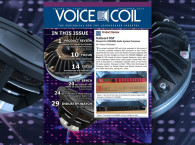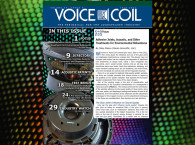 Vance Dickason kicks off the July 2024 issue of Voice Coil with an introduction to a topic that is top of mind for audio product designers, product managers and brands: the use of digital signal processing. In this case, Outboard DSP. While home audio is dominated by passive crossover designs, studio monitor loudspeakers are dominated by active crossover designs. While it’s true that rack-mount active crossovers were always available, whether active or passive, multiway crossover networks must be designed for specific transducers: one size does not fit all.
Vance Dickason kicks off the July 2024 issue of Voice Coil with an introduction to a topic that is top of mind for audio product designers, product managers and brands: the use of digital signal processing. In this case, Outboard DSP. While home audio is dominated by passive crossover designs, studio monitor loudspeakers are dominated by active crossover designs. While it’s true that rack-mount active crossovers were always available, whether active or passive, multiway crossover networks must be designed for specific transducers: one size does not fit all.An increasingly viable solution is to create a complete active solution, driven by DSP, contained in a programmable unit that can be delivered with multiple presets for different usage scenarios or even configured by the user, according to the system in place. As Vance Dickason explains, this is a topic that inspired him to begin a series of product reviews featuring solutions such as the Danville Signal dspNexus, miniDSP Flex, and other outboard DSP processors.
This month, Mike Klasco (Menlo Scientific) explores a fascinating topic related to this issue’s focus: Diamond Coatings for Speakers, IEMs, and Headphones. Speaker designers looking to refine their products’ sound quality through diaphragm treatments can now benefit from diamond coatings, or more specifically diamond-like-coatings (DLC), which is a process that matured over the last half-century. The industry has now reached a stage where this technology becomes available and viable.
And for this month’s Voice Coil scheduled focus, Adhesives, Coatings, Sealants, High-Tech Thin Films, Converters, and Dispensing Equipment, Mike Klasco and Nora Wong have compiled an updated directory with vendor profiles for the most relevant suppliers of adhesives to the loudspeaker industry. Also, vendors for enhancing treatments, and obviously the distributors, as the larger adhesives and treatment companies consider the speaker industry too boutique to work with directly. This expanded directory coverage also includes antimicrobial coatings, speaker-centric converters, dispensers, and applicators.

Another Focus article is once again brought courtesy of Claus Futtrup, which for this July 2024 issue discusses the IB4 Bass Reflex Alignment. This is the third article in his series about the invention, concept, and historical perspective of loudspeaker bass reflex alignments. In May 2024 he discussed “Computation of Bass Reflex Alignments,” and in June he followed with the LR4 alignment. For this article, he explores the rarely talked about Inter-Order Butterworth (IB4) alignment, mentioned originally by Richard Small and Neville Thiele.
And for Vance Dickason’s Test Bench, this month we have a double serving of Scan-Speak transducers.
The first Test Bench is the new Scan-Speak 15W/8534T00 5.5” woofer from the brand’s Classic Line. This Scan-Speak family consists at the time of writing of seven midbass drivers and seven tweeters — all either original transducer “hits” from years past or improved versions of the same. The new Scan-Speak 15W/8534T00 sort of fills the gap in the Classic family for a compact high-performance 5.5” (15cm) midbass driver. It is based on the design principles of the popular 18W/8545 continuing the tradition with a slim frame aluminum chassis, a Symmetrical Drive (SD) motor system, a low loss linear rubber suspension, and is updated with a brand-new cone material called Phenomax. The motor assembly is powered by a FEA-optimized ferrite design.

The second Test Bench article addresses the Scan-Speak D3004/606200 tweeter from its Illuminator Line. This new 1” compact neodymium (neo) tweeter utilizes the new generation of Metamodal TPCD diaphragms. Martin Turesson, head of Composite Sound, originally wrote about the metamodal process as applied to diaphragm technology in the February 2022 issue of Voice Coil magazine. As applied to TPCD diaphragms, this means that by judiciously adjusting the location of weight and thickness in the diaphragm, you can control the cone modes and resonances. The benefits of controlling resonant break-up modes are obvious. Scan-Speak has been participating in Composite Sound’s metamodal development program, and the new D3004 tweeter is the first result to be released. Besides the 1” TPCD metamodal diaphragm, the feature set for the Scan-Speak D3004/606200 tweeter includes a low resonance injection-molded rear chamber (Fs=430Hz), black anodized machined aluminum faceplate, patented Symmetrical Drive (SD-2) neodymium motor structure, and large-roll coated cloth surround.
In this month’s Industry Watch, Vance Dickason discusses upcoming Audio Engineering Society (AES) conferences, Audio & Loudspeaker Technology International (ALTI) activity updates, and upcoming trade shows. Also discussed is the decision by Audio Precision to retire the venerable AP 2700 Series analyzers, and trade in those units for a new APx52x, APx58x, or APx555 series analyzer with up to 25% discount.

This issue of Voice Coil is now available for download and already in the mail to print subscribers. Subscribers can go to - www.gotomyvcoil.com - to download this issue.
Remember, Voice Coil is available in print and download for all registered subscribers, free for industry professionals. To qualify for a free subscription to Voice Coil, or to renew your subscription, go to: Voice Coil Subscriber Services.
To access the digital subscription platform, just login using your subscriber number and post/zip code as displayed on your mailing label.









